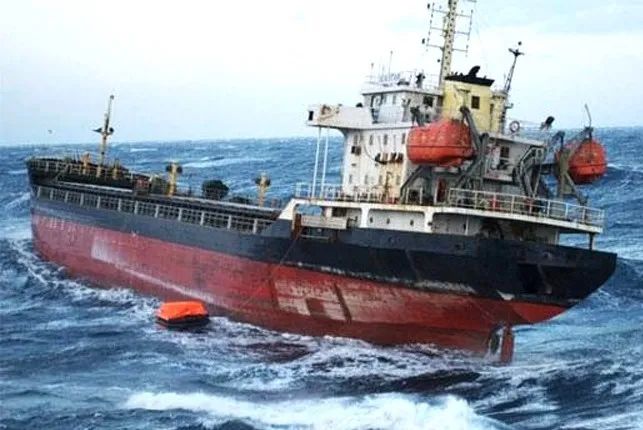船舶在恶劣天气中出现严重的倾斜和倾覆
Vessel takes on significant list and founders in heavy weather

01、事故经过
What happened?
事故船舶最近更换了管理公司,全部新聘接班船员上了该船。在与上任船员进行了简短的交接后,该船空载开航。上任船员报告说,所有的双层底压载舱都是满的,边舱已压载60%到65%(约占总压载容量的80%)。但接班的船员没有核实压载舱的状态。
The ship had recently undergone a change of management company and a totally new crew joined the ship. Following a brief handover from the previous crew, the ship sailed with no cargo. The previous crew reported that all the double bottom ballast tanks were full and the wing ballast tanks were 60% to 65% full (about 80% total ballast capacity). The replacement crew did not verify the status of the ballast tanks.
在下一个港口,该船的货舱和甲板上共装载了116个20尺的集装箱(估计总共有1900吨)。船员们没有改变压载配置,这意味着除了装载的货物外,该船的压载量仍为总压载量的80%左右。船员们仍然没有核实压载舱的状况。
In the next port a total of 116 loaded twenty-foot-equivalent containers were loaded in the holds and on deck (estimated 1,900 tonnes in total). The crew made no changes to the ballast configuration, meaning that in addition to the loaded cargo the ship was still ballasted to about 80% total ballast capacity. The crew had still not verified the status of the ballast tanks.
这艘船出发前往下一个港口,并在那里加了淡水,然后出发前往最终目的地。出发后不久,该船遭受了由季风和台风共同作用造成的恶劣天气,此时,台风正通过海峡向北移动。
The ship departed for the next port, where it took on fresh water before departing for its final destination. Shortly after departing, the ship encountered heavy weather caused by a combination of the monsoon winds and a typhoon, which was tracking northwards through a strait.
船只摇晃得很厉害,朝着来自右舷的风浪,向右舷倾斜约25度。大约一个小时后,倾斜度增加到30度。船长在没有试图确定倾斜的原因后,就发出了求救信号,并命令全部12名船员弃船进入救生筏。船员们最终都被直升机从救生筏中安全救出。
The ship was rolling heavily and developed a list of about 25 degrees to starboard, towards the wind and waves that were coming from the starboard side. After about one hour the list increased to 30 degrees. Without attempting to establish the cause of the list, the master issued a Mayday and ordered the 12-in-total crew to abandon ship into a liferaft. The crew were all safely retrieved from the liferaft by helicopter.
当船员们登上直升机时,他们注意到船体倾斜了大约45度。甲板上的所有集装箱仍在原位,由于没有停止主机和发电机的运转,船上的照明系统仍然处于正常状态。船员们报告说,船上的设备或系统没有明显的故障,甲板上的集装箱也没有移动。船员们认为,货舱里的集装箱没有移动,因为这些集装箱在船的两边紧紧地挤在一起,不可能有明显的横向移动。
When the crew boarded the helicopter, they noted the ship was listing about 45 degrees. All of the deck containers were still in place, and as they had left the main engine and generators running, the lights were still burning. The crew reported that there had been no noticeable failure of the ship's equipment or systems, and there had been no movement of the containers on deck. The crew assumed that there was no movement of the containers in the holds because the containers were so tightly packed athwart ships that no appreciable transverse movement would have been possible.
六天后,搜索发现该船仍然漂浮在海上,并向右舷倾斜15至30度。所有甲板上的集装箱都不见了,但舱口盖却在原处,看起来完好无损。然而,当一艘打捞拖船在大约四天后到达时,该船已经沉没。
Six days later a search found the ship still afloat and listing between 15 and 30 degrees to starboard. All of the deck containers were missing, but the hatch covers were in place and appeared intact. However, when a salvage tug arrived about four days later, the ship had sunk.
02、事故原因
Why did it happen?
这艘船出现倾斜并随后沉没的原因没有得到最终确认。
The cause of the ship taking on a list and subsequently sinking was not conclusively identified.
船员们没有充分认识到预报的天气状况的严重性,因此,该船没有实施恶劣天气程序。
The crew were not fully aware of the severity of the forecast weather conditions and consequently, the ship had not implemented heavy weather procedures.
该船的航向在大浪中受到了影响,导致持续了一段时间的剧烈摇晃。
The course of the ship was beam on to a heavy sea and swell, resulting in heavy rolling for a sustained period of time.
在没有任何其他明显因素的情况下,船舶出现严重倾斜的原因可能与进水导致的稳性变化和/或压载舱状态的未知变化有关。
In the absence of any other obvious factors, the reason for the ship developing a heavy list is likely related to a change in stability resulting from an ingress of water, and/or an uninitiated change in the status of the ballast tanks.
船员们在事故发生前三周多就已经登船,他们没有核实每个压载舱的水量。因此,船上计算机进行的船舶出发前的稳性计算可能并不代表船舶的实际稳性状况。
The crew had not verified the amount of water in each ballast tank since they had boarded the ship more than three weeks before the casualty. Therefore, the pre-departure stability calculation made on the ship's stability computer might not have been a true representation of the ship's actual stability condition.
船员们没有采取任何行动来确定船舶倾斜的原因,因此没有采取任何补救措施(如有可能)。
The crew took no action to identify the reason for the ship taking on a list and therefore took no remedial action (if any was possible).
船员们没有在事故航次出发前对他们的船进行适当的熟悉。新的船舶管理公司在接管该船后,似乎对新船员缺乏支持和帮助。
The crew were unlikely to have been properly familiarized with their ship before it departed on the accident voyage.There appeared to be minimal support and assistance provided to the new crew by the new ship management company when it took over the operation of the ship.
03、事故启示
What can we learn?
船员必须完全熟悉一艘新船,特别是当全体船员进行更换时。
It is essential that the officers and crew be fully familiar with a new ship, particularly when an entire crew change has taken place.
船长和甲板部驾驶员必须检查和监测货物、压舱水和所有其它液体在船上的分布情况,以便随时准确了解船舶的稳性。
It is essential that the master and deck officers check and monitor the distribution of cargo, ballast and all other fluids within their ship in order to have an accurate appreciation of the ship's stability at all times.
船长和船员应该对航行中可能遇到的天气有充分的了解,并在遇到任何恶劣天气之前为船舶做好相应的准备。
The master and crew should have a good appreciation of the likely weather to be encountered during the voyage, and prepare the ship accordingly before any adverse weather is encountered.
当船舶发生异常情况时,如发生了严重倾斜,应及早作出一切努力去查明原因并采取补救措施,以免为时已晚。
When something unusual happens to a ship, such as taking on a substantial list, all early efforts should be made to identify the cause and take remedial action before it is too late.
04、本文对谁有用?
Who may benefit?
海员、船舶经营人、船东、
船舶运营商。
Seafarers, ship managers, shipowners, ship operators.
知识补给站

恶劣天气下的船舶预防措施
1. 根据本船航线、吨位、船型等情况,制定防台防汛应急预案,明确各岗位职责,并定期开展应急演练和救生设备等相关知识培训;
2. 船舶驾驶员要充分利用NAVTEX、FAX等气象设备提前了解航经区域的天气情况,收到台汛警报后要立即报告船长;
3. 定期检查船舶防台防汛设备、水密设施和救生消防设备等,及时做好维护保养;
4. 船长和驾驶员要定期学习气象知识,准确识别气象预报信息中的恶劣天气标识和等级,防止遗漏天气预警信息;
5. 台汛期,船员应尽量在生活区内活动,减少到甲板等室外场地活动,若必须到室外,需系好安全带,另一端与船舶固定处连接;
6. 如需进行室外作业、吊装作业、开关舱等危险作业时,要避开恶劣天气影响时段。
寒潮大风季节来临,船舶应密切关注气象及预警信息,加强设备维护和值守,务必遵守水上交通安全规定,加强值班、注意瞭望、谨慎驾驶,遇到水上险情请及时拨打求救电话“12395”。
09-18 来源:信德海事网
10-10 来源:信德海事网 苏婉
05-07 来源:信德海事网
01-27 来源:信德海事网
12-21 来源:信德海事网
02-11 来源:信德海事网
09-24 来源:信德海事网
12-30 来源:信德海事网
01-08 来源:蓝盾安检创新工作室
06-30 来源:航运安全新动态